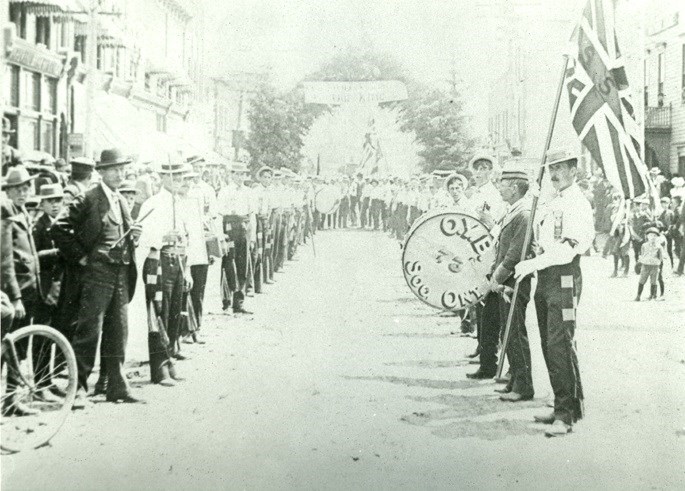From the archives of the Sault Ste. Marie Public Library:
Throughout its history, Sault Ste. Marie has been home to many colourful fraternal organizations and lodges – not the least of which being the Orange Order.
The order began in Ireland for the purposes of furthering Protestant interests. The group got its name from William of Orange, a Protestant king who was victorious over Catholic King James II at the 1690 Battle of the Boyne. Amongst the defining features of the group are conservative ideals, Protestant beliefs, and support for the monarchy.
Each year, on July 12, members of the Orange Order often march in commemoration of this victory, celebrating Orangemen’s Day.
The Orange Order came to Canada with Irish and British immigrants, becoming a politically-significant organization here and quickly attracting non-Irish members to its lodges as well. It boasted four Prime Ministers as members: Sir John A. Macdonald, John Abbott, Mackenzie Bowell, and John Diefenbaker in addition to numerous premiers and other politicians.
Locally, the Orange Order was the subject of much praise in early Sault Star articles. One column from 1908 described one of the Orange associations, Bryant Lodge, as being “composed of worthy young townsmen” and “a credit to the town.”
While many details about the organization were open to the public, the Grand Master for Ontario said, in an event in Sault Ste. Marie, that a certain level of mystery was “necessary to prevent imposture or intrusion.”
There were multiple lodges in the city, all associated with the Orange Order. Many were identifiable by the initials L.O.L. after the lodge name, standing for “Loyal Orange Lodge.” In 1913, a new Orange Hall on King Street opened, built by the Morning Star Lodge, L.O.L., and to be used by all Orange Order groups in the Sault. The 1928-29 City Directory listed nine different Orange societies: Country Lodge, District L.O.L.; Orange Young Britons; Morning Star; L.O.L. New Hope; Loyal True Blues; Royal Black Knights of Ireland; Ladies’ Orange Lodge St. Mary’s; and Ladies’ Orange Lodge, Livingstone.
In general, in Sault Ste. Marie, the Orange Order acted as a fraternal order, supporting its members as well as putting on social and leisure events such as dances and dinners. And, of course, they held parades on July 12.
However, the organization was not without its dark side.
More generally, the organization has a turbulent history in Ireland, where Protestant/Catholic tensions frequently came to a head and erupted in violence. To a lesser extent, the group also sparked violence within Canada, including several riots in 19th-century Toronto – with few repercussions, due in part to the presence of Orangemen in positions of political power.
The group was known in Canada for being extremely anti-French, supporting the concept of “One Canada,” and viewing biculturalism and bilingualism as an aggressive threat. They also were known for their anti-Catholic views. In the 1920s, the Catholic Register, a Canadian Catholic newspaper, compared the Orange Order to the KKK, claiming that “the aggressive virulence of the Ku Klux Klan . . . is directly due to its Orange membership, for Orangemen, being weak in America, can work only through and by affiliation with aggregations of native bigots.”
Each week, the Sault Ste. Marie Public Library and its Archives provides SooToday readers with a glimpse of the city’s past.
Find out more of what the Public Library has to offer at www.ssmpl.ca and look for more Remember This? columns here
